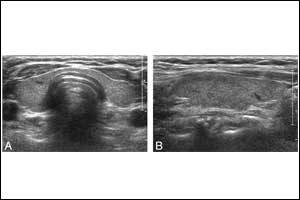- Home
- Editorial
- News
- Practice Guidelines
- Anesthesiology Guidelines
- Cancer Guidelines
- Cardiac Sciences Guidelines
- Critical Care Guidelines
- Dentistry Guidelines
- Dermatology Guidelines
- Diabetes and Endo Guidelines
- Diagnostics Guidelines
- ENT Guidelines
- Featured Practice Guidelines
- Gastroenterology Guidelines
- Geriatrics Guidelines
- Medicine Guidelines
- Nephrology Guidelines
- Neurosciences Guidelines
- Obs and Gynae Guidelines
- Ophthalmology Guidelines
- Orthopaedics Guidelines
- Paediatrics Guidelines
- Psychiatry Guidelines
- Pulmonology Guidelines
- Radiology Guidelines
- Surgery Guidelines
- Urology Guidelines
Real-time sonography differentiates diffuse thyroid disease from normal thyroid parenchyma

The real-time sonography (US) is diagnostically accurate and can be used for differentiating diffuse thyroid disease (DTD) from normal thyroid parenchyma, finds a new study published in the American Journal of Roentgenology.
Hye Shin Ahn, Department of Radiology, Chung-Ang University Hospital, Chung-Ang University College of Medicine, Seoul, South Korea, and colleagues conducted the multicenter study to assess the diagnostic accuracy of real-time US for differentiating DTD from normal thyroid parenchyma among radiologists blinded to patients' clinical, serologic, and imaging history and to determine the differences in diagnostic accuracy among radiologists from different institutions.
Thyroiditis is the group of inflammatory disorders that affect the thyroid gland and is very often encountered in clinical practice. Thyroiditis can be painless or painful. The suggested classification of thyroiditis is chronic, subacute and acute.
The chronic lymphocytic type of thyroiditis is Hashimotos and it is known to have an autoimmune basis. Graves' disease and Hashimoto's thyroiditis are the most commonly encountered thyroid disorders. A diffuse or multifocal decrease in echogenicity demonstrated on ultrasound is the hallmark of many types of thyroiditis.
Read Also: Point-of-Care Ultrasonography more sensitive,specific for detecting Fluid
For the study, 214 patients underwent thyroid US and subsequent thyroid surgery at four participating institutions from January to March 2017. Real-time US was performed at each institution by an attending radiologist, who classified US diagnoses into one of the following four categories based on US findings: no DTD, indeterminate, suspicious for DTD, and DTD. The outcomes of US diagnoses were compared with histopathologic results to determine the diagnostic accuracy of real-time US at each institution.
Key Findings:
- Histopathologic results included normal thyroid parenchyma, Hashimoto thyroiditis, non-Hashimoto lymphocytic thyroiditis, and diffuse hyperplasia.
- Normal thyroid parenchyma and DTD exhibited statistically significant differences in echogenicity, echotexture, size, glandular margin, vascularity of thyroid, and US classification.
- There was a positive correlation between US classification and histopathologic results at all institutions for detecting DTD.
- The highest diagnostic indexes were obtained when the cutoff criterion was suspicious for DTD.
- There was favorable diagnostic accuracy, with statistically significant differences, at all institutions for the diagnosis of DTD.
The authors concluded that "Real-time US can be helpful for differentiating DTD from normal thyroid parenchyma" .
For more information log on to 10.2214/AJR.17.19164

Disclaimer: This site is primarily intended for healthcare professionals. Any content/information on this website does not replace the advice of medical and/or health professionals and should not be construed as medical/diagnostic advice/endorsement or prescription. Use of this site is subject to our terms of use, privacy policy, advertisement policy. © 2020 Minerva Medical Treatment Pvt Ltd